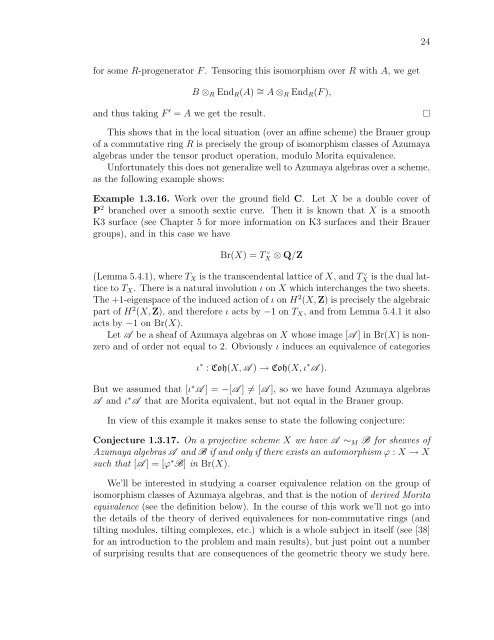derived categories of twisted sheaves on calabi-yau manifolds
derived categories of twisted sheaves on calabi-yau manifolds
derived categories of twisted sheaves on calabi-yau manifolds
Create successful ePaper yourself
Turn your PDF publications into a flip-book with our unique Google optimized e-Paper software.
for some R-progenerator F . Tensoring this isomorphism over R with A, we get<br />
B ⊗R EndR(A) ∼ = A ⊗R EndR(F ),<br />
and thus taking F ′ = A we get the result.<br />
This shows that in the local situati<strong>on</strong> (over an affine scheme) the Brauer group<br />
<str<strong>on</strong>g>of</str<strong>on</strong>g> a commutative ring R is precisely the group <str<strong>on</strong>g>of</str<strong>on</strong>g> isomorphism classes <str<strong>on</strong>g>of</str<strong>on</strong>g> Azumaya<br />
algebras under the tensor product operati<strong>on</strong>, modulo Morita equivalence.<br />
Unfortunately this does not generalize well to Azumaya algebras over a scheme,<br />
as the following example shows:<br />
Example 1.3.16. Work over the ground field C. Let X be a double cover <str<strong>on</strong>g>of</str<strong>on</strong>g><br />
P 2 branched over a smooth sextic curve. Then it is known that X is a smooth<br />
K3 surface (see Chapter 5 for more informati<strong>on</strong> <strong>on</strong> K3 surfaces and their Brauer<br />
groups), and in this case we have<br />
Br(X) = T ∨<br />
X ⊗ Q/Z<br />
(Lemma 5.4.1), where TX is the transcendental lattice <str<strong>on</strong>g>of</str<strong>on</strong>g> X, and T ∨<br />
X is the dual lattice<br />
to TX. There is a natural involuti<strong>on</strong> ι <strong>on</strong> X which interchanges the two sheets.<br />
The +1-eigenspace <str<strong>on</strong>g>of</str<strong>on</strong>g> the induced acti<strong>on</strong> <str<strong>on</strong>g>of</str<strong>on</strong>g> ι <strong>on</strong> H2 (X, Z) is precisely the algebraic<br />
part <str<strong>on</strong>g>of</str<strong>on</strong>g> H2 (X, Z), and therefore ι acts by −1 <strong>on</strong> TX, and from Lemma 5.4.1 it also<br />
acts by −1 <strong>on</strong> Br(X).<br />
Let A be a sheaf <str<strong>on</strong>g>of</str<strong>on</strong>g> Azumaya algebras <strong>on</strong> X whose image [A ] in Br(X) is n<strong>on</strong>zero<br />
and <str<strong>on</strong>g>of</str<strong>on</strong>g> order not equal to 2. Obviously ι induces an equivalence <str<strong>on</strong>g>of</str<strong>on</strong>g> <str<strong>on</strong>g>categories</str<strong>on</strong>g><br />
ι ∗ : Coh(X, A ) → Coh(X, ι ∗ A ).<br />
But we assumed that [ι ∗ A ] = −[A ] = [A ], so we have found Azumaya algebras<br />
A and ι ∗ A that are Morita equivalent, but not equal in the Brauer group.<br />
In view <str<strong>on</strong>g>of</str<strong>on</strong>g> this example it makes sense to state the following c<strong>on</strong>jecture:<br />
C<strong>on</strong>jecture 1.3.17. On a projective scheme X we have A ∼M B for <str<strong>on</strong>g>sheaves</str<strong>on</strong>g> <str<strong>on</strong>g>of</str<strong>on</strong>g><br />
Azumaya algebras A and B if and <strong>on</strong>ly if there exists an automorphism ϕ : X → X<br />
such that [A ] = [ϕ ∗ B] in Br(X).<br />
We’ll be interested in studying a coarser equivalence relati<strong>on</strong> <strong>on</strong> the group <str<strong>on</strong>g>of</str<strong>on</strong>g><br />
isomorphism classes <str<strong>on</strong>g>of</str<strong>on</strong>g> Azumaya algebras, and that is the noti<strong>on</strong> <str<strong>on</strong>g>of</str<strong>on</strong>g> <str<strong>on</strong>g>derived</str<strong>on</strong>g> Morita<br />
equivalence (see the definiti<strong>on</strong> below). In the course <str<strong>on</strong>g>of</str<strong>on</strong>g> this work we’ll not go into<br />
the details <str<strong>on</strong>g>of</str<strong>on</strong>g> the theory <str<strong>on</strong>g>of</str<strong>on</strong>g> <str<strong>on</strong>g>derived</str<strong>on</strong>g> equivalences for n<strong>on</strong>-commutative rings (and<br />
tilting modules, tilting complexes, etc.) which is a whole subject in itself (see [38]<br />
for an introducti<strong>on</strong> to the problem and main results), but just point out a number<br />
<str<strong>on</strong>g>of</str<strong>on</strong>g> surprising results that are c<strong>on</strong>sequences <str<strong>on</strong>g>of</str<strong>on</strong>g> the geometric theory we study here.<br />
24
















